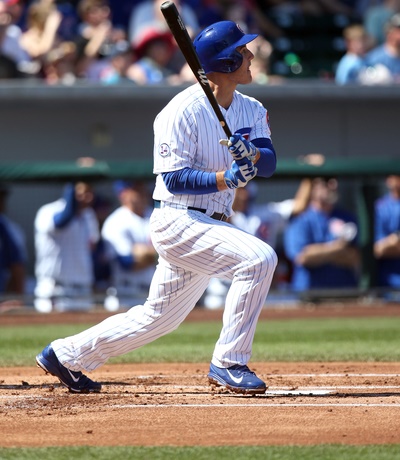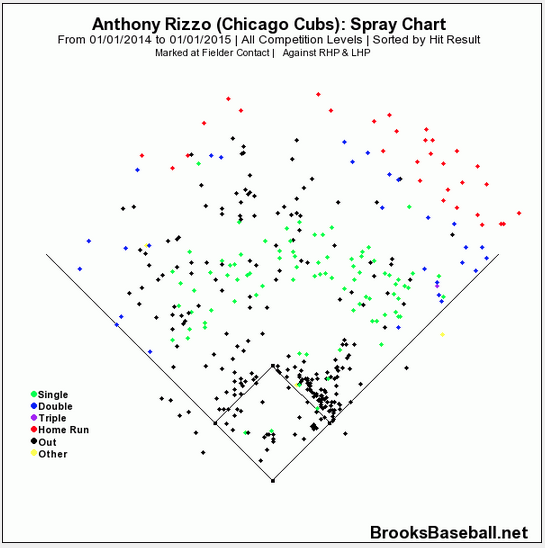During the 2014 season, Anthony Rizzo became what he had long been projected to be: a very good major-league hitter. His TAv of .336 was third in the National League, as was his 153 wRC+; in both cases he finished behind two nobodies named Andrew McCutchen and Giancarlo Stanton. His ISO of .240, meanwhile, was second, again behind Stanton. It would not be unreasonable to say that, in 2014, Rizzo was the best left-handed hitter in the National League.
Because, like many following the Cubs, I was curious to see if Rizzo’s 2014 was sustainable, and hopeful that it was, I paid particularly close attention to Rizzo’s plate appearances during spring training this year. After just a few games, I was somewhat concerned. It seemed to me that Rizzo was hitting ground balls into the shift a lot, and that this was deflating both his BABIP and, consequently, his on-base percentage. If I was correct in this observation, and it sustained itself, Rizzo would seemingly be in line for some lower performance in 2015.
Because the human mind is uniquely fallible, I decided not to trust my own, and instead sought out Rizzo’s spring training batted-ball profile, hoping to find that my anecdotal observation was belied by the data. Unfortunately, what I found—at least initially—was that Rizzo’s spring training batted-ball profile was equally fallible, in the sense that it does not exist anywhere on the internet that I could find.
I therefore combed through the box scores of each spring training game Rizzo appeared in this year and logged three data points for each of his plate appearances: the handedness of the pitcher Rizzo faced, the direction, if any, he hit the ball in, and whether he hit the ball in the air or on the ground. (Line drive statistics were not available, hence the simplistic division between ground and ‘air’ balls, which are typically divided into fly balls and line drives.) The raw results are here, and can be used to construct a rudimentary batted-ball profile.
During this year’s spring training (inclusive of two exhibition games against the Diamondbacks) Rizzo came to the plate sixty times. After eliminating seven strikeouts and five walks, we are left with forty-eight plate appearances that ended with contact. The following table summarizes those plate appearances.
Overall ST Batted-Ball Profile (Rizzo) [N=48]
| Handedness | ||
| vs. LHP % | vs. RHP % | L/R = 0.50 |
| 33.3% | 66.7% | |
| Type | ||
| GB % | AB % | GB/AB = 0.72 |
| 41.7% | 58.3% | |
| Direction | ||
| LF % | CF % | RF % |
| 22.9% | 22.9% | 54.2% |
In short, Rizzo faced mostly right-handed pitchers, hit the ball in the air more often than not, and hit the ball largely to right field. Let’s break this down a little further, and see if we find anything particularly concerning. Here are those same stats, with handedness held constant:
ST vs. LHPs (Rizzo) [N=16]
| Type | ||
| GB % | AB % | GB/AB = 0.78 |
| 43.8% | 56.3% | |
| Direction | ||
| LF % | CF % | RF % |
| 18.8% | 31.3% | 50.0% |
ST vs. RHPs (Rizzo) [N=32]
| Type | ||
| GB % | AB % | GB/AB = 0.68 |
| 40.6% | 59.4% | |
| Direction | ||
| LF % | CF % | RF % |
| 25.0% | 18.8% | 56.3% |
Not a lot to see here. Rizzo hits the ball marginally more to right field versus RHPs, and the division of balls between left and center field changes a little, but on the whole the profiles are pretty similar. Let’s look at the same data again, but this time holding the type of ball he hits constant:
ST, hit on the ground (Rizzo) [N=20]
| Handedness | ||
| vs. LHP % | vs. RHP % | L/R = 0.54 |
| 35.0% | 65.0% | |
| Direction | ||
| LF % | CF % | RF % |
| 10.0% | 5.0% | 85.0% |
ST, hit in the air (Rizzo) [N=28]
| Handedness | ||
| vs. LHP % | vs. RHP % | L/R = 0.47 |
| 32.1% | 67.9% | |
| Direction | ||
| LF % | CF % | RF % |
| 32.1% | 35.7% | 32.1% |
Well, this is sort of interesting. Take a look at those ‘Direction’ stats. When Rizzo hits the ball in the air, it could honestly go anywhere: left, center, and right are all within four percent of one another. But when he hits the ball on the ground, you already know where it’s going: right field. There might be something here. One last split: this time, we’ll hold the direction of the hit constant:
ST, hit to left (Rizzo) [N=11]
| Handedness | |
| vs. LHP % | vs. RHP % |
| 27.3% | 72.7% |
| Type | |
| GB % | AB % |
| 18.2% | 81.8% |
ST, hit to center (Rizzo) [N=11]
| Handedness | |
| vs. LHP % | vs. RHP % |
| 45.5% | 54.5% |
| Type | |
| GB % | AB % |
| 9.1% | 90.9% |
ST, hit to right (Rizzo) [N=26]
| Handedness | |
| vs. LHP % | vs. RHP % |
| 30.8% | 69.2% |
| Type | |
| GB % | AB % |
| 65.4% | 34.6% |
Huh. Also interesting. When Rizzo hit the ball to left or center field, this spring, it was almost invariably a fly ball. When he hit the ball to right, meanwhile, it was a ground ball about two-thirds of the time. In short, then, we have a picture of Anthony Rizzo, circa spring training 2015: He hits a lot of balls to right field, and when he hits them there, he hits them on the ground.
The problem with that version of Anthony Rizzo, of course, is that it’s a version opposing teams can defend against pretty easily. Here, courtesy of Brooks Baseball, is Rizzo’s spray chart for the 2014 season. That enormous mass of black dots you see on the right side of the infield are his groundouts, mostly to a second baseman positioned right in between second and first base, as if he were playing shortstop in mirror-image.
Were you to wish things about Anthony Rizzo, then, you might wish that he wouldn’t hit so very many ground balls to the right side. And yet that’s exactly what he did during spring training. But, then again, it’s spring training. Why get yourself worked up about just forty-eight plate appearances? Batted-ball profiles take about a month of regular-season plate appearances to stabilize, and Rizzo certainly didn’t get to the requisite number during spring training.
Let me show you two more batted-ball profiles, whose identities I’ll keep anonymous for the time being:
Profile #1
| Handedness | ||
| vs. LHP % | vs. RHP % | L/R = 0.62 |
| 38.4% | 61.6% | |
| Type | ||
| GB % | AB % | GB/AB = 0.56 |
| 36.1% | 63.9% | |
| Direction | ||
| LF % | CF % | RF % |
| 19.4% | 35.9% | 44.6% |
Profile #2
| Handedness | ||
| vs. LHP % | vs. RHP % | L/R = 0.46 |
| 31.3% | 68.7% | |
| Type | ||
| GB % | AB % | GB/AB = 0.74 |
| 42.5% | 57.5% | |
| Direction | ||
| LF % | CF % | RF % |
| 24.3% | 33.5% | 42.2% |
As you might have guessed, these are Rizzo’s 2014 and 2013 seasons, respectively. And what do we see? We see, in 2013, a GB/AB ratio of 0.74 that is remarkably similar to this year’s spring training value of 0.72, and markedly higher than 2014’s 0.56. Moreover, compared to both years, we see an elevated number of balls hit to right this spring training. On the face of it, Rizzo’s 2015 spring training looks a lot like his 2013 season.
So, is this cause for concern? Despite the similarities, the answer is probably no. As has already been mentioned, batted-ball profiles take a while to stabilize, and spring training is often a time for established hitters like Rizzo to work on various things in preparation for the season. It is, nonetheless, something to keep an eye on. If the Cubs are going to contend in 2015, they’ll need Rizzo to be the hitter he was last year, not the one he was two years ago. At least insofar as spring training this year was concerned, that was not the case.


Here’s the thing: Virtually everyone hits the ball mostly on the ground to their pull side, and mostly in the air to the opposite field. You can look at every player in the league, and it’s true of 80 percent or more of them. Rizzo is actually impressive, and has remained so this spring, it seems to me, in that he pulls the ball in the air as often as he does.
I dunno, I’m not sure we’re seeing anything there.
Very happy to defer to your experience here – I’ll take a dig into this midseason and see if anything interesting is showing up, this time in comparison to the league. It’s definitely a weakness of this piece.